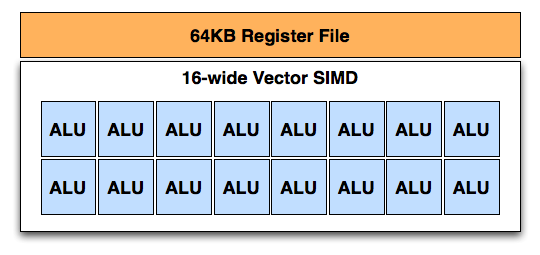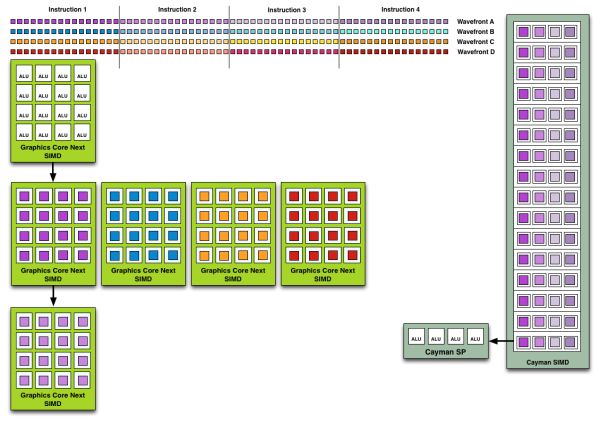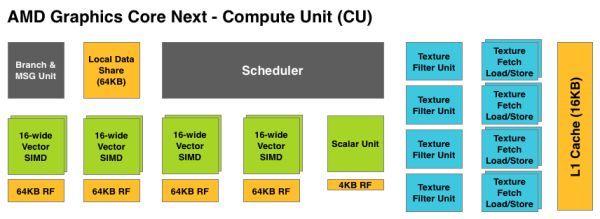AMD Radeon HD 7970 Review: 28nm And Graphics Core Next, Together As One
by Ryan Smith on December 22, 2011 12:00 AM EST- Posted in
- GPUs
- AMD
- Radeon
- ATI
- Radeon HD 7000
A Quick Refresher, Cont
Having established what’s bad about VLIW as a compute architecture, let’s discuss what makes a good compute architecture. The most fundamental aspect of compute is that developers want stable and predictable performance, something that VLIW didn’t lend itself to because it was dependency limited. Architectures that can’t work around dependencies will see their performance vary due to those dependencies. Consequently, if you want an architecture with stable performance that’s going to be good for compute workloads then you want an architecture that isn’t impacted by dependencies.
Ultimately dependencies and ILP go hand-in-hand. If you can extract ILP from a workload, then your architecture is by definition bursty. An architecture that can’t extract ILP may not be able to achieve the same level of peak performance, but it will not burst and hence it will be more consistent. This is the guiding principle behind NVIDIA’s Fermi architecture; GF100/GF110 have no ability to extract ILP, and developers love it for that reason.
So with those design goals in mind, let’s talk GCN.
VLIW is a traditional and well proven design for parallel processing. But it is not the only traditional and well proven design for parallel processing. For GCN AMD will be replacing VLIW with what’s fundamentally a Single Instruction Multiple Data (SIMD) vector architecture (note: technically VLIW is a subset of SIMD, but for the purposes of this refresher we’re considering them to be different).

A Single GCN SIMD
At the most fundamental level AMD is still using simple ALUs, just like Cayman before it. In GCN these ALUs are organized into a single SIMD unit, the smallest unit of work for GCN. A SIMD is composed of 16 of these ALUs, along with a 64KB register file for the SIMDs to keep data in.
Above the individual SIMD we have a Compute Unit, the smallest fully independent functional unit. A CU is composed of 4 SIMD units, a hardware scheduler, a branch unit, L1 cache, a local date share, 4 texture units (each with 4 texture fetch load/store units), and a special scalar unit. The scalar unit is responsible for all of the arithmetic operations the simple ALUs can’t do or won’t do efficiently, such as conditional statements (if/then) and transcendental operations.
Because the smallest unit of work is the SIMD and a CU has 4 SIMDs, a CU works on 4 different wavefronts at once. As wavefronts are still 64 operations wide, each cycle a SIMD will complete ¼ of the operations on their respective wavefront, and after 4 cycles the current instruction for the active wavefront is completed.
Cayman by comparison would attempt to execute multiple instructions from the same wavefront in parallel, rather than executing a single instruction from multiple wavefronts. This is where Cayman got bursty – if the instructions were in any way dependent, Cayman would have to let some of its ALUs go idle. GCN on the other hand does not face this issue, because each SIMD handles single instructions from different wavefronts they are in no way attempting to take advantage of ILP, and their performance will be very consistent.

Wavefront Execution Example: SIMD vs. VLIW. Not To Scale - Wavefront Size 16
There are other aspects of GCN that influence its performance – the scalar unit plays a huge part – but in comparison to Cayman, this is the single biggest difference. By not taking advantage of ILP, but instead taking advantage of Thread Level Parallism (TLP) in the form of executing more wavefronts at once, GCN will be able to deliver high compute performance and to do so consistently.
Bringing this all together, to make a complete GPU a number of these GCN CUs will be combined with the rest of the parts we’re accustomed to seeing on a GPU. A frontend is responsible for feeding the GPU, as it contains both the command processors (ACEs) responsible for feeding the CUs and the geometry engines responsible for geometry setup. Meanwhile coming after the CUs will be the ROPs that handle the actual render operations, the L2 cache, the memory controllers, and the various fixed function controllers such as the display controllers, PCIe bus controllers, Universal Video Decoder, and Video Codec Engine.
At the end of the day if AMD has done their homework GCN should significantly improve compute performance relative to VLIW4 while gaming performance should be just as good. Gaming shader operations will execute across the CUs in a much different manner than they did across VLIW, but they should do so at a similar speed. And for games that use compute shaders, they should directly benefit from the compute improvements. It’s by building out a GPU in this manner that AMD can make an architecture that’s significantly better at compute without sacrificing gaming performance, and this is why the resulting GCN architecture is balanced for both compute and graphics.












292 Comments
View All Comments
Scali - Monday, December 26, 2011 - link
Lol, how's that, when I'm the one saying that AMD's cards are the best performers in Crysis 2?I'm neutral, a concept that is obviously alien to you. Idiots...
Scali - Monday, December 26, 2011 - link
Heck, I'm also the guy who made Endless City run on non-nVidia cards. How does that make me an nVidia fanboy?CeriseCogburn - Thursday, March 8, 2012 - link
That's sad when an nvidia fanboy has to help all the amd fannies with software coding so they can run a benchmark, then after all that work to help the underprivileged, nothing but attacks after the facts... finally silence them.It's really sad when the truth is so far from the pop culture mind that actually speaking it is nearly forbidden.
Thank you for helping them with the benchmark. Continue to be kind in such ways to the sour whining and disgruntled, as it only helped prove how pathetic amd dx11 was...
james007 - Friday, December 30, 2011 - link
This sounded like such an awesome card and I was psyched to get it the moment it comes out -- until reading the part about dropping the 2nd DVI port. A DisplayPort-to-SLDVI doesn't do it, for me, because my desktop has to drive two 30" displays. In fact, I would love to be able to drive a third display so I can have a touch-screen also. My current (previous-generation) VDC does drive both displays just fine.This does not seem like such an infrequent requirement, especially for high-end users. Why would they drop the ability to drive the 2nd display? !!!
Argh!
The_Countess666 - Saturday, December 31, 2011 - link
not trying to sell you anything but, HDMI to dual-link dvi does exist (see link, or google yourself for other shops).http://sewelldirect.com/hdmi-to-dvi-dual-link-cabl...
and these cards do have 1 HDMI-out so that should work for you.
Penti - Wednesday, January 4, 2012 - link
It's the IHV that makes those decisions any way, just because it's not on a reference card doesn't mean they won't show up or that you can't build a card with it. But the HDMI supports more then 1920x1200 finally on this card any how. I guess they could deliver a card with the old type of DVI>HDMI adapters. Obviously opting for HDMI and multidisplaycapable displayport 1.2 makes more sense though. It's been around for years now.Penti - Wednesday, January 4, 2012 - link
Just make sure you actually has the number of connections you need when buying the card, many 7970 bords only appear to support single-link DVI on the DVI-connector.poordirtfarmer2 - Wednesday, January 4, 2012 - link
Enjoyed the article.So this new 79XX architecture is about a GPU architecture that’s also good for “compute work”. The reference to NVIDIA ‘s professional video cards (Quadro ; Telsa), implies to me that this might mean video cards viable for use both in gaming and in engineering / video work stations.
I’m not a pro, but do a lot of video editing, rendering and encoding. I’ve avoided dedicating a machine with an expensive special purpose QUADRO video card. Am I reading the wrong thing into this review, or might the new 79XX and the right driver give folks like me the best of both worlds?
radojko - Thursday, January 5, 2012 - link
UVD 3 in NextGen is a disappointing. Nvidia is two generation in front with PureVideo HD 5.psiboy - Monday, January 9, 2012 - link
Well Mr Ryan Smith I must ask why the omission of 1920 x 1080 in al lbenchmarks... given that almost every new monitor for quite some time has been natively 1920 x 1080... what is it with you guys and Tom's lately.. you both seem to have been ignoring the reality of what most of your readers are using!